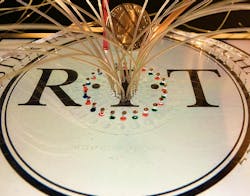Optical device leverages CRISPR-Cas13a technology for early Ebola detection
After 40 years of research, an effective vaccine for the deadly and highly contagious Ebola virus remains elusive. Thus, early detection is key for controlling outbreaks—the most recent of which killed more than 1000 individuals, according to the U.S. Centers for Disease Control.
Now, a rapid, point-of-care (POC), fluorescence-based microfluidics screening device, developed at the Rochester Institute of Technology (Rochester, NY), aims to decrease Ebola’s spread, and enable infected individuals to get treatment earlier.1 “Before any symptoms of Ebola, such as cough or fever present, individuals can take a blood test,” says Ke Du, assistant professor of mechanical engineering in RIT’s Kate Gleason College of Engineering, who led the work.
The system features a biochemistry array for in-field pathogen detection and uses CRISPR gene-editing technology to monitor and detect nucleic acid markers (see figure). There are several prominent strains of Ebola, and the multidisciplinary team of engineers and biochemists from China, Korea, and the U.S. focused on EBOV, a strain with a high mortality rate. Inspired by the tragedy of the 2014 outbreak—in which nearly three months elapsed while blood samples were transported from West Africa to Europe for analysis, and more than 11,000 lives were lost before Ebola was confirmed—the work targets areas lacking laboratory resources and trained personnel.
Aiming to develop low-cost a method for rapid, POC serological assay with minimal sample manipulation, the researchers report an easy-to-use, automated, amplification-free microfluidic platform that detects Ebola RNA using RNA endonuclease Cas13a. This target-specific and -sensitive method offers several advantages over existing methods, which require complicated solid phase extraction.
CRISPR and fluorescence
When bound to target viral RNA at exceedingly low concentrations, Cas13a, one of the CRISPR-Cas systems, releases fluorophores as a result of cleaving random RNA strands. Without amplification, a single RNA target can cleave ~10,000 fluorescence probes at physiological temperature (~37°C), which equates to signal amplification of four orders of magnitude. When target RNA is not present, background signal is low.
The approach uses a tiny sample of blood obtained with a finger prick. A parabolic mirror-based fluorometer enables high-sensitivity detection of the fluorescence signal. The fluorescence unit, which integrates with the microfluidic chip, provides sensitivity comparable to that of a confocal microscope, yet it is considerably smaller and lighter weight. And while microscope images require interpretation expertise, the fluorescence signal (which can be calibrated for unknown virus concentration measurements and virus detection) is easy to read.
Within the fluorometer, a continuous-wave 488 nm laser directly excites each sample solution in microfluidic chip’s reservoir, which can be aligned by adjusting the three-axis translation stage. For photodamage control, a variable neutral-density filter enables reduction of laser power to 3 W/cm2, and an f-200 mm planoconvex lens serves to slightly defocus the beam to a spot ~500 μm in diameter. An off-axis parabolic (OAP) mirror enables collection of the fluorescence signal, while a 488 nm notch filter eliminates scattered light, and fluorescence is focused into an optical fiber on a three-axis translation stage connected to a miniature spectrometer.
The compact, portable unit is easy to align, and requires no optics expertise for field operation. The integrated system, including fluorometer and microfluidics, costs ~$3300—total cost per assay, including reagents, disposable chip, and associated parts, is ~$6. Analysis is approximately 25X faster than with polymerase chain reaction (PCR), the current standard technology. Overall, detection time is ~15 min starting from the raw blood sample. It can screen 24 subjects in parallel, and can process 24 samples within 30 min. Because it requires just 10 μL purified total RNA for a reaction, it is compatible with finger-prick tests, enabling easy-to-perform self-diagnosis. In POC settings, total RNA can be rapidly purified from 50 μL blood samples by using an off-chip commercial kit before introducing the RNA into the microfluidic system.
Further integration, more viruses
The researchers note that with further work, RNA extraction and detection can be integrated on the same chip. Future studies are also required to test whether the method would be effective in the field for samples from early symptomatic patients. In addition, Du is working on a method to detect multiple virus strains from Ebola to influenza and Zika, for example. “I grew up in China and experienced the 2002-2004 SARS outbreak…if we can have early detection systems to help screen for all types of diseases and patterns, this can be very useful because it can provide information to medical doctors and microbiologists to help develop the vaccines, and early detection and identification can control and even prevent outbreaks.”
REFERENCE
1. P. Qin et al., ACS Sensors, 4, 4, 1048–1054 (2019).
About the Author

Barbara Gefvert
Editor-in-Chief, BioOptics World (2008-2020)
Barbara G. Gefvert has been a science and technology editor and writer since 1987, and served as editor in chief on multiple publications, including Sensors magazine for nearly a decade.
